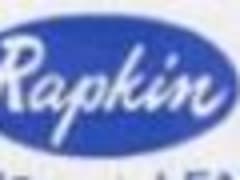Type of EphemeraBank Bags
South Africa
Type of Ephemera
Bank Bags
Company Info
Absa Group Limited, formerly Barclays Africa Group Limited, and originally Amalgamated Banks of South Africa, is an African based financial services group, offering personal and business banking, credit cards, corporate and investment banking, wealth and investment management as well as bancassurance. Absa was founded in 1991 through the merger of financial service providers United Bank (South Africa), the Allied Bank (South Africa), the Volkskas Bank Group and certain interests of the Sage Group. The following year, Absa acquired the entire shareholding of the Bankorp Group which included Trustbank, Senbank and Bankfin. In the early years of this union, each bank operated under its own name. In 1998, they were fused into one single brand. A year later, Absa adopted a new corporate identity and the name was changed into Absa Group Limited In May 2005, Barclays Bank of the United Kingdom purchased 56.4% stake in Absa. In early 2007, the Barclays Bank acquisition of Absa was criticised by governor of the South African Reserve Bank, Tito Mboweni who said he "had yet to see the benefits of Barclays' management of Absa". In 2013, the group acquired the entire issued share capital of Barclays Africa Limited and issued 129,540,636 Consideration Shares to Barclays Africa Group Holdings Limited (a wholly owned subsidiary of Barclays) thus increasing the shareholding of Barclays plc to 62,3%. The Consideration Shares were listed on the JSE from the commencement of trading on 31 July 2013. The name change from “ABSA Group Limited” to “Barclays Africa Group Limited” was announced on 22 July 2013, and became effective 2 August 2013. In 2017, the South African Public Protector, Busisiwe Mkhwebane, found that the bailout of R1.125 billion that Absa's predecessor Bankorp Group had received between 1985 and 1992 from the Reserve Bank was illegal, and recommended that Absa be forced to pay back R2.25 billion, the current equivalent of the amount. The report was set aside by the Pretoria High Court, finding that "The public protector did not conduct herself in a manner which would be expected from a person occupying the office of the public protector." The court assessed some costs of the case personally against Mkhwebane due to her conduct. an order upheld by the Constitutional Court of South Africa in July 2019 In March 2018, Barclays Africa announced the group's name would revert to Absa Group Limited, effective 30 May 2018. The company underwent re-branding in 2018, inclusive of a new logo and slogans.


Company
Absa
South Africa
Type of Ephemera
Bank Bags
Company Info
Amalgamated into Absa


Company
Allied Bank
South Africa
Type of Ephemera
Bank Bags
Company Info
Absa Group Limited, formerly Barclays Africa Group Limited, and originally Amalgamated Banks of South Africa, is an African based financial services group, offering personal and business banking, credit cards, corporate and investment banking, wealth and investment management as well as bancassurance.
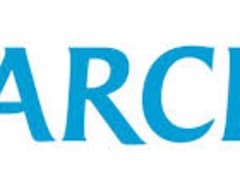


Company
Barclays 1
South Africa
Type of Ephemera
Bank Bags
Company Info
Absa Group Limited, formerly Barclays Africa Group Limited, and originally Amalgamated Banks of South Africa, is an African based financial services group, offering personal and business banking, credit cards, corporate and investment banking, wealth and investment management as well as bancassurance.



Company
Barclays 2
South Africa
Type of Ephemera
Bank Bags
Company Info
Absa Group Limited, formerly Barclays Africa Group Limited, and originally Amalgamated Banks of South Africa, is an African based financial services group, offering personal and business banking, credit cards, corporate and investment banking, wealth and investment management as well as bancassurance.



Company
Barclays 3
South Africa
Type of Ephemera
Bank Bags
Company Info
First National Bank is one of South Africa's "big five" banks. It is a division of First Rand Limited, a large financial services conglomerate, which trades on the Johannesburg Securities Exchange, under the symbol: FSR. First National Bank (FNB; Afrikaans: Eerste Nasionale Bank (ENB)) is one of South Africa's "big five" banks. It is a division of First Rand Limited, a large financial services conglomerate, which trades on the Johannesburg Securities Exchange (JSE), under the symbol: FSR. FNB is also listed on the Botswana Stock Exchange under the symbol FNBB and is a constituent of the BSE Domestic Company Index. According to its website, FNB is the oldest bank in South Africa. It traces its origins back to the Eastern triocrees Province Bank, which was formed in Grahamstown in 1838. At that time the bank financed the wool export boom in the district. By 1874, the bank had four branches - at Grahamstown, Middelburg, Cradock and Queenstown. Due to a recession the bank was bought out in 1874 by the Oriental Bank Corporation (OBC). However, as a result of financial difficulties that the Oriental Bank Corporation was experiencing in India, it decided to withdraw from South Africa and thus the Bank of Africa was formed in 1879 to take over the OBC's business in South Africa. At about the same time, the government of the South African Republic desired to create a local commercial bank, due to the discovery of gold in Barberton and the Witwatersrand. The government thus created a bank through a concession agreement. The task of the bank was to focus primarily on financing agricultural development. A state mint was also established as part of the concession. The Nationale Bank der Zuid-Afrikaansche Republiek Beperk (National Bank of the South African Republic Limited) was registered in Pretoria in 1891 and opened for business on 5 April of the same year. After the conclusion of the Second Anglo-Boer War in 1902, the name of this bank was changed to the National Bank of South Africa Limited. Due to another recession, the Bank of Africa was bought out by the National Bank in 1912, which had already bought out another bank, the National Bank of the Orange River Colony in 1910. The Natal Bank, which was founded in 1854 to fund the Natal Colony's sugar industry, also suffered financial difficulties and was taken over in 1914. By this time, the National Bank was now one of the strongest and largest banks in South Africa. However, by the early 1920s, the National Bank was suffering from bad debt and heavy losses. It consequently merged with the Anglo-Egyptian Bank and the Colonial Bank in 1925 to form Barclays Bank (Dominion, Colonial and Overseas).[5] In 1971 Barclays restructured its operation and its South Africa operation was renamed Barclays National Bank Limited. Due to a disinvestment campaign against South Africa because of its apartheid policies, Barclays was forced to reduce its shareholding and sold its shareholding in the bank in 1986. The bank was renamed "First National Bank of Southern Africa Limited" in 1987 and became a wholly South African owned and controlled entity. In 1998, the financial services interests (which included their shareholding in First National Bank) of Rand Merchant Bank Holdings and Anglo-American Corporation were merged to form First Rand Limited, which is listed on the JSE Securities Exchange. In consequence, FNB became a wholly owned subsidiary of First Rand Limited; it currently trades as a division of FirstRand Bank Limited.[6] In 1999 the First National Bank was mentioned in the 'Ciex Report' that summarised a two-year long investigation into the theft of R26 billion from the state during the apartheid era. The investigators claimed that FNB unlawfully received hundreds of millions of Rands from the SARB. The money was disguised as 'lifeboats' for covering bad loans. True to 2017 the stolen funds have yet to be recovered.[7]



Company
FNB
South Africa
Type of Ephemera
Bank Bags
Company Info
Nedbank Group is a financial services group in South Africa offering wholesale and retail banking services as well as insurance, asset management, and wealth management. Nedbank Limited is a wholly owned subsidiary of Nedbank Group. Nedbank's primary market is South Africa. Nedbank Group is a financial services group in South Africa offering wholesale and retail banking services as well as insurance, asset management, and wealth management. Nedbank Limited is a wholly owned subsidiary of Nedbank Group. Nedbank's primary market is South Africa. Nedbank also operates in six other countries in the Southern African Development Community (SADC), through subsidiaries and banks in Lesotho, Malawi, Mozambique, Namibia, Swaziland and Zimbabwe, as well as offices in Angola and Kenya. Outside Africa, Nedbank have offices to provide international financial services for Africa-based clients in Guernsey, Isle of Man, Jersey, the United Kingdom and the United Arab Emirates. In 2014, Nedbank acquired an associate stake of 20% in Ecobank. The Nedbank-Ecobank Alliance is the largest banking network in Africa, with more than 2,000 branches in 39 countries. Nedbank is headquartered in Johannesburg. Market capitalization was ZAR125 billion (approximately US$9.1 billion), as of June 2018. The bank was founded in 1888 in Amsterdam as the Nederlandsche Bank en Credietvereeniging voor Zuid-Afrika ("Dutch Bank and Credit Union for South Africa"). In the same year, the bank opened an office in Church Street, Pretoria, South Africa. In 1903, the company was renamed to Nederlandsche Bank voor Zuid-Afrika ("Dutch Bank for South Africa"). In 1906, the bank expanded and an office in London was opened. The bank split in 1951, renaming its South African counterpart as Nederlandse Bank in Suid-Afrika/Netherlands Bank of South Africa (NBSA). In 1969, the number of South African shareholders increased significantly and the company became 100% South African-owned after the Bank Mees and Hope sold 20% of its shares. The South African counterpart was completely independent. The Dutch counterpart of the bank no longer exists. Syfrets SA and Boland Bank listed on the Johannesburg Stock Exchange in 1969. In 1971, NBSA changed its name to Nedbank. Nedbank Group formed from the merger of Syfrets SA, Union Acceptances and Nedbank in 1973. In 1986, Old Mutual became the major shareholder (53%) of Nedbank. In 1992, Syfrets, UAL Merchant Bank, and Nedbank Investment Bank Division merged to become Nedcor Investment Bank (NIB). Old Mutual, Nedcor's holding company, was demutualised and listed on the London Stock Exchange in 1999. It became a constituent of the FTSE 100 Index. Nedcor and Old Mutual joined in an offshore private banking venture and acquired the Isle of Man and Jersey private banking business of Robert Fleming & Co. in 2001. The new Nedcor Group was formed on 1 January 2003, combining Nedcor, BoE, Nedcor Investment Bank, and Cape of Good Hope Bank into one legal entity. The Nedcor Group was renamed the Nedbank Group on 6 May 2005. As part of the managed separation, on 15 October 2018, Old Mutual reduced its shareholding in Nedbank Group to 19.9%.
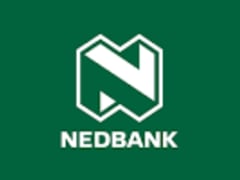


Company
Nedbank
South Africa
Type of Ephemera
Bank Bags
Company Info
The Standard Bank of South Africa Limited is a South African financial services group and is Africa’s biggest lender by assets. The company's corporate headquarters, Standard Bank Centre, is situated in Simmonds Street, Johannesburg.



Company
Standard Bank 1
South Africa
Type of Ephemera
Bank Bags
Company Info
The Standard Bank of South Africa Limited is a South African financial services group and is Africa’s biggest lender by assets. The company's corporate headquarters, Standard Bank Centre, is situated in Simmonds Street, Johannesburg.



Company
Standard Bank 2
South Africa
Type of Ephemera
Bank Bags
Company Info
Absa Group Limited, formerly Barclays Africa Group Limited, and originally Amalgamated Banks of South Africa, is an African based financial services group, offering personal and business banking, credit cards, corporate and investment banking, wealth and investment management as well as bancassurance.



Company
Trust Bank
South Africa
Type of Ephemera
Bank Bags
Company Info
Amalgamated and became Absa


Company
United Bank
South Africa
Type of Ephemera
Bank Bags
Company Info
Volkskas Beperk was a South African bank founded in 1934 as a cooperative loan bank, becoming a commercial bank in 1941. In 1991, by which time it had become South Africa's largest Afrikaner bank, Volkskas merged with United Building Society, Allied Building Society and Trust Bank to form Amalgamated Banks of South Africa. The bank issued banknotes for circulation in South West Africa between 1949 and 1959 from its Windhoek branch. Volkskas was formally opened on February 1, 1935 in the De Villiers building in Pretoria by J.J. Bosman and a typist. It was registered as a cooperative loan bank under the Co-Operative Societies Act and thus began serving Afrikaners forced by the Great Depression to move to the city between 1929 and 1933. The bank was already registered on July 9, 1934 as Volkskas (Koöperatief) Beperk (i.e. "Limited"). The bank provided credit union services in which people could set up savings or deposit accounts, and clients could obtain bank loan installments against the signature of two friends or other approved security. After four months in business, the bank turned a profit of R17.06. At this stage, the bank had no branches and two tellers. The first branch was opened on August 1, 1935, on Mark Street in Johannesburg. The premises on which the building stood were the first property owned by Volkskas. Expansion In 1939, Volkskas began opening checking accounts. Negotiations with the other large banks of the time came to nothing, so on March 1, 1941, Volkskas began circulating its first checks. Within three weeks, the other banks began accepting Volkskas's checks. That same year, it also expanded to become a full commercial bank, realizing the founders' long-awaited dream. Full banking status brought rapid expansion and a solid economic footing to the company. Volkskas's inter-registration with established local banks under the Banking Law of 1942 helped it connect better with the local economy, to the point that in 1947, it became a member of the Settlement Banking Office and set up agency agreements with other area banks in towns where the latter were unrepresented. Already in 1946, overseas representation began to meet the growing needs of clients who conducted transactions through other channels in other countries. This branch was aided by Volkskas getting certification in 1947 as a foreign currency handler. The bank handled most currencies of the world. Further growth In 1950, it was decided to change the name from Volkskas to Suid-Afrikaanse Nasionale Handelsbank Bpk. The name had already been approved by the authorities by Barclays Bank (D.C. & O.), and a suit was filed in the High Court of South Africa over the name. In 1951, the verdict was resolved in Barclays's favor. In 1952, J.J. Bosman, founder of Volkskas, died. At the time of his death, it was already the third-largest bank in South Africa. On August 22, 1952, the 100th branch was opened in Strand, Western Cape by Dr. T.E. Dönges. Later that year, a branch also opened in Transkei. Changes in the financial world required Volkskas to eventually diversify into other industries. The bank entered the leasing field with the purchase of Trans-Orange Finance and Development Bank and long-term financing through the Volkskas Belegginskorporasie Beperk. Volkskas helped found the Nasionale Bouvereniging, which later played a primary role in supporting Afrikaner interests in construction along with Saambou. The bank has been computerized since 1967. The integration of wholesale banking by the company was also a highlight. Volkskas Aksepbank Beperk ("Volkskas Merchant Banking Limited") established operations to serve corporate clients in the industries of industrial materials, mining, trade and real estate, public corporations, and local authorities. Volkskas Industriële Bank Beperk provided wholesale financing for large lease-to-buy and rental transactions with a focus on industrial materials. Volkskas Kommersiële Eiendomme Beperk was the division handling property interests (other than branches). This expansion required the group to restructure so the divisions could fully realize their profit potential. A new bank holding company, Volkskas-Groep Beperk, was founded with five active subsidiaries, including Volkskas Beperk, Volkskas Aksepbank Beperk, Volkskas Industriële Bank Beperk, Volkskas Nywerhede Beperk, and Volkskas Kommersiële Eiendomme Beperk. In 1978, the Volkskas Building (now ABSA Centre Pretoria) opened. In the early 1990s, the Amalgamated Banks of South Africa (ABSA) group was formed from the merger of United, Allied, and Volkskas Groups with part of the Sage Group. This resulted from the acquisition of the Bankorp Group in 1992. These banks all traded under their own names until 1998, when United, Volkskas, Allied, and TrustBank all merged under the ABSA umbrella.



Company
Volkskas Bank
Type of EphemeraEnvelope
South Africa
Type of Ephemera
Envelope
Company Info
No Info
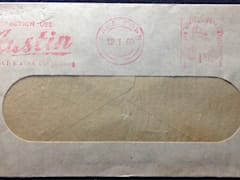
Company
Austin Hot water cylinders
South Africa
Type of Ephemera
Envelope
Company Info
Absa Group Limited, formerly Barclays Africa Group Limited, and originally Amalgamated Banks of South Africa, is an African based financial services group, offering personal and business banking, credit cards, corporate and investment banking, wealth and investment management as well as bancassurance.



Company
Barclays
South Africa
Type of Ephemera
Envelope
Company Info
now called the Bay Hotel

Company
Bay Beach Hotel
South Africa
Type of Ephemera
Envelope
Company Info
No Info

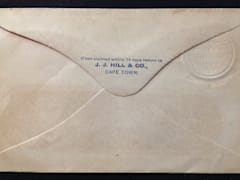
Company
Bethlehem Jams and Fruits
South Africa
Type of Ephemera
Envelope
Company Info
No Info

Company
Cape Dairies
South Africa
Type of Ephemera
Envelope
Company Info
Columbit was founded in 1937 by the Late Mr Ernest Zeh, a German immigrant from Meinz. The company was officially registered in 1938 after Mr Zeh realised that there were many opportunities to introduce European technology and know- how to the African market. Over the years the company has built a reputation based on integrity and sound values. The company is fully committed to its’ suppliers, customers and staff. Columbit has strong ties with their suppliers who ensure that we are kept up to date with all the latest technological developments coming out of Europe. Today Columbit is a dynamic, diversified operation supplying top quality consumables, equipment and service to the wine, food and beverage industries in South Africa, Australia and New Zealand. All divisions are ably supported by a knowledgeable sales team, qualified technicians, and superb aftermarket spares and support staff. Always attentive to the needs of our customers and their continuous search for quality, we are constantly on the look-out for new technology that will provide value added opportunities to our customers.


Company
Columbit
ZAR
Type of Ephemera
Envelope
Company Info
The firm of WM Cuthbert & Co, shoe merchants, was established in 1882. Their Johannesburg building was designed by architects Stucke & Bannister and was completed in 1904. It rapidly became a major landmark in the mining town and retains many of its Victorian details. It was declared a National Monument under old NMC legislation on 27 June 1986.


Company
Cuthbert's
South Africa
Type of Ephemera
Envelope
Company Info


Company
Eagle Cement and Marble Works
South Africa
Type of Ephemera
Envelope
Company Info
No Info

Company
Ensign
South Africa
Type of Ephemera
Envelope
Company Info
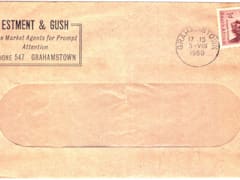
Company
Estment & Gush
Type of Ephemera
Envelope
Company Info
Foodmark AB is a Swedish food company that produces and markets products under the Rydbergs, Lohmanders, Fjällbrynt , Delikatessfabriken, Jensens Kitchen, K-Salat and Mills brands. Foodmark's product portfolio includes mayonnaise-based salads , sauces , dressings , broth butter , soft cheese , liver pies and liver sausage and its products are manufactured in Albyberg (Haninge), Klintehamn , Vidsel, Norway and Denmark . Foodmark annually produce 20,000 tons of food to grocery stores and food service, and in 2018 the company had 245 employees and had sales of 827 million kronor . The head office is located in Sundbyberg , Stockholm . The company is part of the Norwegian Family Group Agra A / S .


Company
Foodmark
Gough Island
Type of Ephemera
Envelope
Company Info
Gough Island, also known historically as Gonçalo Álvares after the Portuguese explorer, is a rugged volcanic island in the South Atlantic Ocean. It is a dependency of Tristan da Cunha and part of the British overseas territory of Saint Helena, Ascension and Tristan da Cunha. The details of the discovery of Gough Island are unclear, but the most likely occasion is July 1505 by the Portuguese explorer Gonçalo Álvares.[6] Maps during the next three centuries named the island after him. On some later maps, this was erroneously given as Diego Alvarez. According to some historians, the English merchant Anthony de la Roché was the first to land on the island, in the austral autumn of 1675.[7][8][9] Charles Gough rediscovered the island on 3 March 1732, thinking it was a new find.[10] It had been named Gonçalo Álvares since 1505 after the captain of Vasco da Gama's flagship on his epic voyage to the east, and under this name it was marked with reasonable accuracy on the charts of the South Atlantic during the following 230 or so years. Then, in 1732, Captain Gough of the British ship Richmond reported the discovery of a new island, which he placed 400 miles to the east of Gonçalo Álvares. Fifty years later cartographers realised that the two islands were the same, and despite the priority of the Portuguese discovery, and the greater accuracy of the position given by them, "Gough's Island" was the name adopted.[11] In the early 19th century, sealers sometimes briefly inhabited the island. The earliest known example is a sealing gang from the U.S. ship Rambler (Captain Joseph Bowditch) which remained on the island in the 1804–1805 season.[12] The sealing era lasted from 1804 to 1910 during which 34 sealing vessels are known to have visited the island, one of which was lost offshore.[13] The Scottish National Antarctic Expedition on the Scotia made the first visit to the island by a scientific party on 21 April 1904, when William Speirs Bruce and others collected specimens.[14] The Shackleton–Rowett Expedition also stopped at the island in 1922.[15] Gough Island was formally claimed in 1938 for Britain, during a visit by HMS Milford of the Royal Navy.[16] In 1995, the island was inscribed as a UNESCO World Heritage Site. In 2004, the site was extended to include Inaccessible Island and renamed Gough and Inaccessible Islands. Gough Island is the only place outside South America from which the solar eclipse of September 12, 2034, will be visible; the centre of the path of totality crosses over the island.

Company
Gough Island
South Africa
Type of Ephemera
Envelope
Company Info


Company
Johannesburg Municipal Pension and Provident Funds
ZAR
Type of Ephemera
Envelope
Company Info


Company
Liddles
South Africa
Type of Ephemera
Envelope
Company Info
Meadow Feeds is regarded as the market leader in the Southern African animal feed industry. Our company produces a variety of specialised diets and custom feed mixes for the poultry, dairy, ostrich and swine industries. Meadow Feeds also supplies a full range of technical services to its customers, including advice on nutrition, feeding programs, animal husbandry and production techniques. Meadow’s historical and continued success is driven by ensuring nutritional supremacy and the consistency of supplying quality animal feeds and nutritional solutions to its globally competitive customers.


Company
Meadow Feeds
ZAR
Type of Ephemera
Envelope
Company Info
Engen Petroleum is a South African oil company focusing on the downstream refined petroleum products market and related businesses. The company’s core functions are the refining of crude oil, the marketing of primary refined petroleum products and the provision of convenience services via an extensive retail network. Until 1990, it was part of Mobil Oil. In 1993, it changed the brand name to Engen. The company is present in 17 countries and exports products to over 30 more countries, mostly in Africa and the Indian Ocean Islands. Engen operates a refinery in Durban that has a nameplate capacity of 120,000 barrels (19,000 m3) per day and operates approximately 1,450 service stations across sub-Saharan Africa and Indian Ocean Islands. A number of Engen's service stations are operated on a franchise basis. Engen operates its own transport fleet with approximately 180 bulk fuel tankers. Engen has partnered with numerous South African businesses, including Woolworths, Wimpy, Debonairs Pizza, and Steers, which have operations at certain Engen service stations. Today, Engen Petroleum is active in South Africa, Botswana, Namibia, Zimbabwe, Mozambique, Kenya, Ghana, Gabon, Tanzania, Rwanda, Zambia, Malawi, Lesotho, Swaziland, Mauritius, Réunion and The Democratic Republic of the Congo. The company is also listed on the Botswana Stock Exchange and is a constituent of the BSE Domestic Company Index. Ownership Until 1990 Mobil South Africa 1990-1996 Gencor 1996 30% PETRONAS 1998 100% PETRONAS 1998-2017 80% PETRONAS and 20% Phembani Group Today 74% PETRONAS, 20% Phembani Group and 6% Phembani-led Consortium


Company
Mobil
South Africa
Type of Ephemera
Envelope
Company Info
In 1884, John Henry Patterson bought out his fellow investors in the National Manufacturing Company and formed the National Cash Register Company, the predecessor of NCR Corporation. Located in Dayton, Ohio, this company made cash registers. The company grew slowly, producing only 16,000 registers in its first decade in operation. Through aggressive marketing and advertising, by 1914 the National Cash Register Company was producing 110,000 cash registers per year. In 1906, the company manufactured the first electric cash register. Few cash registers were sold in the early years of the company’s operation due to lack of demand. However, Patterson was confident that once owners understood how the register reduced theft there would be an upsurge of demand. He created the American Selling Force, a committee within the company that would act as traveling salesmen. These workers were paid on commission, trained on a universal script, and sent on visits to other businesses to promote their product. The NCR also began buying smaller firms to form a monopoly. Patterson, as well as a few other NCR CEOs, was convicted in the mid-1910s of breaking the Sherman Anti-Trust law. Patterson was well known for his compassion for his employees. He provided women workers with coffee and soup for lunch. Machine operators sat on actual chairs with backs for support rather than on stools. He provided his workers with indoor bathrooms. Patterson implemented a ventilation system to provide clean air to his workers. He also maintained a doctor's office in his factory to assist injured workers as quickly as possible. The National Cash Register Company engaged in civic work as well. Following the Dayton flood of 1913, the company provided approximately $1 million to assist people in recovering from the disaster. The company allocated an additional $600,000 to study how the community could prevent flooding in the future. In addition to these efforts, Patterson donated money to help build parks and playgrounds. He also provided funds to create the first public kindergarten in Dayton. Patterson died on May 2, 1922. His son, Frederick B. Patterson, assumed control of the National Cash Register Company. That same year, the company had officially produced two million cash registers. It also had begun producing other business machines. During World War I and World War II, the National Cash Register Company contributed to the United States' war effort by manufacturing shell fuses, plane engines, and code-breaking machines, among many other items. During the 1950s and the 1960s, the National Cash Register Company began to produce computers. In 1974, it changed its name to NCR Corporation to symbolize its more diverse product line. In 1991, AT&T acquired the NCR Corporation but decided to end its control of NCR Corporation in 1997. In 2009, NCR Corporation announced the company’s move to Duluth, Georgia. NCR Corporation continues to operate, specializing in office equipment. NCR Corporation, previously known as National Cash Register is an American software, managed and profressional services, consulting and technology company that also makes self-service kiosks, point-of-sale terminals, automated teller machines, check processing systems, and barcode scanners.



Company
National Cash Register Company
England
Type of Ephemera
Envelope
Company Info
British Advent Messenger. The Messenger is the official journal of the Seventh-day Adventist Church in the United Kingdom and Ireland. It is published fortnightly by the British Union Conference of Seventh-day Adventists and printed by the Stanborough Press Limited, Alma Park, Grantham, Lincolnshire, NG31 9SL.

Company
None
South Africa
Type of Ephemera
Envelope
Company Info
No Info


Company
O Acutt Locksmith
UK
Type of Ephemera
Envelope
Company Info
Pall Mall is an American brand of cigarettes produced by R. J. Reynolds Tobacco Company in Winston-Salem, North Carolina, and internationally by British American Tobacco at multiple sites. As of 2012, Pall Mall was R. J. Reynolds' highest selling brand.


Company
Pall Mall
ZAR
Type of Ephemera
Envelope
Company Info
Bakers Limited, commonly known as Bakers, is a South African company producing a wide variety of savoury and sweet biscuits. Bakers is part of National Brands Limited, an FMCG company which is a subsidiary of South African holding company AVI Limited. Bakers products are manufactured in Durban, Pretoria, and Johannesburg. The origins of the company commenced when John Frederick Baumann migrated from England to South Africa, where in 1851 at the age of 26 he established a grocery and bread bakery in Durban, in the British Colony of Natal (now a province of South Africa). In 1879 Baumann visited London where he met with his nephew, John Michael Leonard Baumann, suggesting he emigrate to South Africa. J. M. L. Baumann had previously left his native village in Niederstetten, Germany at the age of 16, and moved to London where he worked as a baker's assistant before acquiring his own bakery business. J. M. L. Baumann arrived in Durban in 1881 and joined his uncle's bakery and grocery business. A few years later when the lease on their premises expired, J. M. L. Baumann purchased the bakery operations from his uncle. He bought a site at the corner of Brickhill Road and West Street, where he constructed a small building. In 1885 Baumann purchased a hand operated biscuit machine for £65 from another baker, Plowright. The machine produced 'dry' biscuits for sale to ships and army garrisons. In 1895 Baumann purchased an advanced biscuit machine and commenced manufacture of more 'fancy biscuits' such as Ginger Nuts and Marie. He printed his first price list and operated under the name L. Baumann & Co The factory survived the anti-German riots of 1915 when the shop and bread and cake premises were burnt down. At the time, the biscuit factory was producing biscuits for the army, and two of JML Baumann's sons were fighting the Germans in the then German colony of South West Africa (now Namibia). The factory was put under government protection to prevent further damage. Due to the anti-German sentiment in 1915, the company's name was changed from Baumann's to Bakers Limited. In 1918 Baumann's son, William, opened a biscuit factory in Cape Town, the business was registered in October 1918 as Selected Products Ltd, trading as Baumann's Biscuits. William sold the company back to Bakers Limited in 1922 but continued to operate it as a subsidiary. At the beginning of the 1930s, almost 200 people were employed and the 1935 wholesale catalogue listed 240 different biscuit lines. Originally biscuits were packed loose in tins and the company was prepared to pay railage on the empty returns. The company then introduced packets which consisted of two layers of paper: one was the familiar blue lattice printed Bakers paper and the other inside layer was of 'pure vegetable parchment'. In 1968 Bakers Ltd established a factory at Isando in the Transvaal. Bakers Ltd then established a new factory at Pinetown, which commenced operations on 6 December 1972. The following year the company closed their operations in Durban and consolidated them at the new Pinetown factory. In 1977 Bakers Ltd built a small factory, Lexim (Pty) Ltd, at Butterworth, Transkei. In 1981 the company was acquired by Anglovaal Industries Limited (AVI). In 1993 AVI purchased Pyotts Pty Ltd, a savoury biscuit manufacturer, and the following year regrouped the companies under the title, Associated Biscuits. In 1996 Associated Biscuits was consolidated into National Brands Limited. In 2014, Bakers entered the breakfast market, launching Bakers Good Morning Breakfast biscuits.


Company
Pyott's
South Africa
Type of Ephemera
Envelope
Company Info
No Info

Company
RFC Worcester
ZAR
Type of Ephemera
Envelope
Company Info
Binne die raamwerk van sy missie en doelstellings ondersoek die Akademie voortdurend aktuele sake van openbare belang, neem standpunt daaroor in, en tree ook meermale adviserend, fasiliterend en meningsvormend in sake van nasionale belang op deur direk by die verloop van gebeure betrokke te raak. Die Akademie is op 2 Julie 1909 gestig en het oor die jare bekend geword weens die gereelde toekenning van literêre pryse (waarvan die Hertzogprys die bekendste is), en ander prestigepryse, sy publikasies (twee gereelde tydskrifte en talle geleentheidspublikasies), die werk van sy Taalkommissie aan die standaardisering van Afrikaans, die talle vakwoordeboeke en terminologielyste wat deur lede van die Akademie opgestel en gepubliseer is.


Company
SA Akademie vir Wetenskap en Kuns
ZAR
Type of Ephemera
Envelope
Company Info


Company
Shell
South Africa
Type of Ephemera
Envelope
Company Info
The first track for steam-powered locomotives was a line of about 3.2 kilometres (2 mi) by the Natal Railway Company, linking the town of Durban with Harbour Point, opened on 26 June 1860.[2] Cape Town had already started building a 72-kilometre (45 mi) line, track gauge 1,435 mm (4 ft 8 1⁄2 in), linking Cape Town to Wellington in 1859 but was hampered by delays and could only open the first section of the line to the Eerste River on 13 February 1862. However Cape railway construction began a massive expansion, after the formation in 1872 of the Cape Government Railways. In the north, in the independent South African Republic, railway construction was done by the Netherlands-South African Railway Company (NZASM), which constructed two major lines: one from Pretoria to Lourenço Marques in Portuguese East Africa Colony, and a shorter line connecting Pretoria to Johannesburg. A national "link-up" was established in 1898, creating a national transport network. This national network was largely completed by 1910. Though railway lines were also being extended outside of South Africa, as far north as Northern Rhodesia (present-day Zambia), the vision of Cecil John Rhodes, to have a rail system that would run from the "Cape to Cairo", would never materialise. Upon the merger of four provinces to establish the modern state of South Africa in 1910, the railway lines across the country were also merged. South African Railways and Harbours (SAR & H) was the government agency responsible for, amongst other things, the country's rail system. Electrification of the railways began in the 1920s with the building of the Colenso Power Station for the Glencoe to Pietermaritzburg route and the introduction of the South African Class 1E. During the 1980s, the transport industry was reorganised. Instead of being a direct government agency, it was modelled along business lines into a government-owned corporation called Transnet. Transnet Freight Rail (until recently known as Spoornet) is the division of Transnet that runs the rail system. Though there are no plans to end government-ownership of the national rail network, some small portions of the rail system have recently been privatised. Network The rail network of South Africa Transnet (and previously Spoornet and its predecessor) became famous for its luxury rail lines, most notably the Blue Train, which runs from Cape Town to Pretoria. The Blue Line has frequently been named the best luxury train line in the world, and the 1,806 kilometres (1,122 mi) run is a popular tourist attraction for South Africa. With the increasing coverage provided by the nation's highway system, long-distance passenger travel has declined in South Africa. While many commuters still use rail for their daily commute, nationally, only half of the nation's 36,000 kilometres (22,000 mi) of track is being fully utilised, and some 35% of the nation's track carries no activity or very low activity. Accordingly, Transnet is moving towards an emphasis on freight, rather than passengers, to keep the rail system profitable. For a look at the South African transport network, including the railways, view this map from the United Nations. A high-speed rail link has been proposed, between Johannesburg and Durban.

Company
South African Railways
South Africa
Type of Ephemera
Envelope
Company Info
No Info

Company
Southern Cross Fund
South Africa
Type of Ephemera
Envelope
Company Info
Spes Bona _ cape town coat of arms
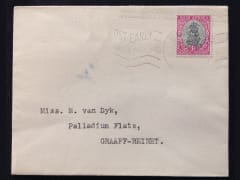

Company
Spes Bona
South Africa
Type of Ephemera
Envelope
Company Info
The bank now known as Standard Bank was formed in 1862 as a South African subsidiary of the British overseas bank Standard Bank, under the name The Standard Bank of South Africa. The bank's origins can be traced to 1862, when a group of businessmen led by the prominent right-wing South African politician John Paterson formed a bank in London, initially under the name Standard Bank of British South Africa. The bank started operations in 1863 in Port Elizabeth, South Africa, and soon after opening it merged with several other banks including the Commercial Bank of Port Elizabeth, the Colesberg Bank, the British Kaffrarian Bank and the Fauresmith Bank. It was prominent in financing and development of the diamond fields of Kimberley in 1867. The word "British" was dropped from the title in 1883. When gold was discovered on the Witwatersrand, the bank expanded northwards and on 11 October 1886 the bank started doing business in a tent at Ferreira's Camp (later to be called Johannesburg), thus becoming the first bank to open a branch on the Witwatersrand gold fields. On 1 November 1901 a second branch was opened in Eloff Street of Johannesburg. Standard Bank in Adderley St, Cape Town Until 1962 the British bank was formally known as the Standard Bank of South Africa, although by then its operations spread across Africa. When the South African operations were formed into a subsidiary in 1962, the parent changed its name to Standard Bank Limited, and the South African subsidiary took its parent's previous name. In 1967 shares in the Standard Bank of South Africa were offered to the South African public, although the British parent company retained over 80% of the shares. The parent bank merged in 1969 with Chartered Bank of India, Australia and China and the combined bank became known as Standard Chartered Bank. In 1969 the Standard Bank Investment Corporation (now Standard Bank Group) was established as the holding company of the South African bank. During the 1970s and 1980s Standard Chartered gradually reduced its shareholding, and sold its remaining 39% stake in Standard Bank Group in 1987, transferring complete ownership of the holding company to South African investors and in particular Liberty Life (and its affiliates), with the latter being the company's major shareholder until 1999.[5] In March 2019, Standard became the first bank in Africa to shift its operations onto Amazon Web Services. In March 2019, the bank announced a reduction of 91 branches and 1200 staff. The decision was taken due to a growing use of self-service channels and a branch network becoming less relevant.


Company
Standard Bank
ZAR
Type of Ephemera
Envelope
Company Info
It was probably Maurice Posner who established the trademark of Three Rings for his biscuit products which became popularly known as 'Three Rings Biscuits'. The emblem was three intertwining circles or rings, each of which had one of the following words on it – Purity, Goodness, Flavour. A Mr Gain of Gain’s Bakery in Johannesburg built a biscuit factory at 19 Siemert Street in Doornfontein in 1920. I visited the premises once or twice in later years and noticed that there was a foundation stone on the side. I was told by my Uncle Albert that the factory was opened by Gain’s wife. He was not very successful as a biscuit manufacturer and went insolvent. After a further two years the factory was bought by the Premier Milling Company which was the largest flour milling group in South Africa at that time, owning mills throughout the country. They changed the name to The Premier Biscuit Company (Pty) Ltd. At the time I became involved in the industry the Managing Director was Mr Maurice Posner whom I suspect had a partial ownership in the company. He was a very astute man, he ran it well and I had to admire his negotiating skills at biscuit conferences. It was probably Maurice Posner who established the trademark of Three Rings for his biscuit products which became popularly known as ‘Three Rings Biscuits’. The emblem was three intertwining circles or rings, each of which had one of the following words on it – Purity, Goodness, Flavour. It can be seen on this old biscuit tin. Photograph on the left : A No. 14 Tin. The three rings trademark circles are shown clearly. Biscuit price increases were few and far between. These were the days before inflation. Possibly once a year the prices by agreement would be increased by either a farthing or a halfpenny per packet (this would be equivalent to a quarter cent or half a cent in today’s currency). Changes were made by mutual agreement. It was impossible for any biscuit manufacturer to raise his prices above others, otherwise he would lose business. The normal procedure at a Conference would be that someone would raise the question of an increase in the prices. We would go round in circles discussing this without achieving anything, Mr Posner arguing against any increase. I believe Mr Posner’s assumed reluctance arose from the fact that in the Transvaal the agreed prices were 1½ pence per pound above the other areas. His profits therefore were probably generous and I think he had to put himself in a position where he could never be accused of willingly making too high a profit. The reason for this difference in pricing goes back to the time when biscuits were imported from Britain and the merchants in Durban priced the biscuits at coastal prices. To cover the cost of transporting these biscuits to the Transvaal another 1½ pence was added by the Transvaal traders. It must be remembered that this was before motorcars had been invented and there was no intrusion of biscuits by coastal manufacturers into the Transvaal. Eventually we would move on to other items and agree to bring up the matter later again in the afternoon. In the afternoon Mr Posner would say that he had been giving further consideration to the question and had consulted his directors. The general conclusion was that they felt in the interests of the industry as a whole they should agree to the price increase proposed by the other members. When I realised that this was the pattern I would usually be the one to make the suggestion after an hour’s discussion that we should leave the matter for a while and could we ask Mr Posner to consider it over the lunch hour so that we could rediscuss it in the afternoon. Inevitably he would agree to the increase when we re-convened. In due course the Premier Milling Group was sold to Westons of the UK and of course the Premier Biscuit Company, being a subsidiary, became part of the Weston empire. At a later stage Mr Tony Bloom followed as Managing Director after the death of his father, Joe Bloom. He closed the factory down. It was probably now too small and too confined in a deteriorating part of Johannesburg. He moved the operation to Springs where the Westons Biscuit Factory already existed and which had become part of the Premier Milling Company’s operation.


Company
Three Rings Biscuits
South Africa
Type of Ephemera
Envelope
Company Info
No Info


Company
Unemployment Commissioners Office
Type of EphemeraGlassine
Australia
Type of Ephemera
Glassine
Company Info
The Australian Postal Corporation, operating as Australia Post, is the government-owned corporation that provides postal services in Australia. The head office of Australia Post is located at 111 Bourke Street, Melbourne, which also serves as a post office. Before colonial control of mail started in 1809, mail was usually passed on by ad hoc arrangements made between transporters, storekeepers and settlers. These arrangements were flexible and depended on cooperation of the country people. It was common for early settlers to ride many miles out of their way to deliver neighbours' mail that had been collected from informal distribution points. The first organisation of a postal service in Australia commenced in 1809 with the appointment in Sydney of the first Postmaster of New South Wales. He was an English ex-convict, Isaac Nichols, who took the post operating from his home in George Street, Sydney. His main job was to take charge of letters and parcels arriving by ship, to avoid the chaos of people rushing aboard ships as soon as they arrived at Sydney's wharves. Nichols would pick up the mail and post a list of recipients outside his house. He would advertise in the Sydney Gazette the names of all those who received mail. Recipients paid a fixed price of one shilling per letter to collect mail from Nichols' home, with parcels costing more depending on how heavy they were. VIP addressees were accorded personal delivery by Nichols. The Postal Act of 1825 allowed the governor to fix postage rates and appoint postmasters outside Sydney, enabling the first organised postal service. Letter deliveries began in 1828 and posting boxes first appeared in 1831. Stamps were not required in those days, as the addressee paid for the letter, not the sender. Postal services grew throughout the Australian colonies as they were established. A regular overland service between Sydney and Melbourne, Port Phillip District began in 1838. Also in 1838, the first prepaid "stamped" letter sheets were introduced in Sydney. By 1849, uniform postal rates were established by agreement between the colonies. Prepaid adhesive stamps were introduced in the 1850s. Victoria was the first to make prepayment by stamps compulsory in 1852. Monthly steamship sea-mail to the United Kingdom was established in 1856. The separate colonies joined the Universal Postal Union in 1891. Following federation in 1901, the colonial mail systems were merged into the Postmaster-General's Department (PMG). This body was responsible for telegraph and domestic telephone operations as well as postal mail. An airmail service was introduced in 1914. The world's first large-scale mechanical mail sorting system was introduced in Australia (according to Australia Post),[citation needed] and operational in the Sydney GPO in 1967. This coincided with the introduction of the current system of 4-digit postcodes in Australia. On 1 July 1975, separate government commissions were created to undertake the operational responsibilities of the PMG. One of these was the Australian Postal Commission, trading as Australia Post. It later became the Australian Postal Corporation on 1 January 1989 when it was corporatised. It continues to trade as Australia Post. Under amendments to the APC Act that came into effect in March 2008, quarantine inspection officers of a state or territory are authorised to request Australia Post to open for inspection packets and parcels sent from interstate which they believe may contain quarantine material. The legislation also authorises Australia Post to remove from the mail articles that are suspected of being scam mail. The 200th anniversary of postal services was celebrated in 2009.

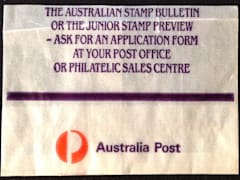
Company
Australia Post
UK
Type of Ephemera
Glassine
Company Info
Based Edinburgh, provides Royal Mail stamps and first-day covers etc to stamp collectors and dealers, active late twentieth early twenty first centuries.

Company
British Philatelic Bureau
Uk
Type of Ephemera
Glassine
Company Info
From The London Gazette - 30 December, 1919 "Notice is hereby given that the Partnership heretofore subsisting between us, the undersigned Edgar Frank Errington and Benjamin Ernest Martin, carrying on business as Stamp Importers and Philatelic Publishers, at Number 17, Gascoyae-road, South Hackney, E. 9, under the style or firm of ERRINGTON & MARTIN, has been dissolved by mutual consent as from the 30th day of June, 1919. All debts due and owing to or by the said late firm will be received or paid by the said Benjamin Ernest Martin, and such business will be carried on in the future by the said Benjamin Ernest Martin.—As witness our hands this 23rd day of December, 1919. E. F. ERRINGTON. B. E. MARTIN"

Company
Errington and Martin
Gibraltar
Type of Ephemera
Glassine
Company Info
The Gibraltar Philatelic Bureau shop stocks all our stamps and philatelic products. Finding the shop is easy, it's situated at the heart of Main Street, outside the Royal Gibraltar Post Office. If you enter Main Street from Casemates just head south and it's on your right. If you are entering Main Street from the Governor's Residence head north and it's on your left. Just ask a 'Bobby' (policeman) if you are unsure! Run by the friendly and knowledgeable Anabel Benson, the shop is open from Monday to Friday 10:00 to 16:00 and Saturdays 10.00 to 13.00. We also stock some coins and banknotes additionally to many Gibraltar stamps and philatelic accessories

Company
Gibraltar Stamps
USA
Type of Ephemera
Glassine
Company Info
Kenmore Stamp Company started in 1932 in a spare office at the Niagara Falls Smelting and Refinery Corporation in upstate New York. Ernest Greenway Jarvis, president and sole owner of the refinery had been advised by his doctor to take up a hobby. He was badly in need of rest and relaxation. Overwork and fatigue were threatening his health. Returning to his boyhood stamp collection, he quickly became absorbed in this fascinating activity and greatly expanded his albums. On a whim he placed an advertisement offering his duplicate stamps for sale to interested collectors. An avalanche of requests poured in. Working late into the night filling orders and answering correspondence wasn't exactly the therapy the doctor had in mind. Nevertheless, Jarvis was overjoyed to be working with stamps again and thrilled to be of service to fellow collectors. He moved his collection and duplicate stamps to an empty office in his plant. Now he could run his main business and take frequent "time outs" to relax and enjoy his stamp activity. He had the best of both worlds and his health and spirit returned on high. New ads soon appeared under the name of Kenmore Stamp Company and this little business came to life. Two employees were hired when stamps were imported from around the world. As business grew, additional space was needed but none was available at the smelting and refinery operation. It, too, was expanding as the threat of war in Europe loomed.


Company
Kenmore Stamp Co
Australia
Type of Ephemera
Glassine
Company Info
Our service is fast, uncomplicated, efficient and friendly . The name MAX STERN has been synonymous with stamp issues of the world, coins ancient and modern, banknotes, fair prices and ethical trading since 1948. That’s why collectors and dealers keep coming back for the famous MAX STERN service, year after year. Retail shop of the year 2003, 2004, 2005, 2006, 2007 and 2008 !!!!! Max was a stamp dealer for over 75 years. When he began stamp dealing at 17, he was the main provider for his family. Remarkably, Max continued to operate his business throughout most of World War II. After escaping the final deportation of Slovaskia’s Jews in October 1944, Max went into hiding with others and following their discovery early in 1945, Max was sent to Sachsenhausen concentration camp near Berlin. When the War ended, Max had survived a death march from Berlin towards Hamburg. Max re-established a stamp business in Bratislava in 1945, but the Communists takeover of Czechoslovakia three years later made it impossible for him to continue. Escaping with his wife Eva, they made their way to Australia. He set up a stamp dealer business in 1950, opening a shop in Melbourne close to his present location in Port Philip Arcade, off Flinders Street. Max Stern’s career nurtured generations of collectors, and was recognized by his appointment as a Member in the General Division of the Order of Australia (AM) in 1999.
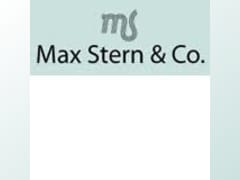

Company
Max Stern & CO.
Namibia
Type of Ephemera
Glassine
Company Info

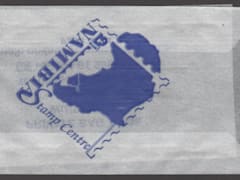
Company
Namibia Stamp Centre - now NamPost
UK
Type of Ephemera
Glassine
Company Info
No Info

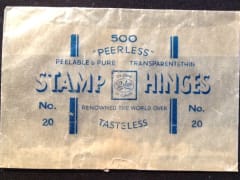
Company
Peerless
South Africa
Type of Ephemera
Glassine
Company Info
No Info

Company
Protea Stamp Service
South Africa
Type of Ephemera
Glassine
Company Info
Cape Town

Company
Sable Stamps
Germany
Type of Ephemera
Glassine
Company Info
We have been supporting the philately with quality, experience and tradition in publishing stamp albums since 1871. Over 100 years experience in numismatic accessories, high quality, good manufacturing, attractive designs and high-grade materials are our philosophy and characteristics. With our commitment to quality, experience and tradition we have been in service for stamp collectors since 1871. Our editorial staff will be pleased to receive your comments and suggestions about our programme. In 1996 we took over the well established programme of numismatic products of the company Ernst Keller, Bretten. Over 100 years experience in numismatic accessories, high quality, good manufacturing, attractive designs and high-grade materials are our philosophy and characteristics. We are producing several millions coin capsules of acrylic glass a year which we are selling to customers all over the world. A wide range of accessories completes our publishing house programme. We are offering the well-known MICHEL-catalogues from Scott-Publishing, USA, and Stanley Gibbons, Great Britain, as well as the stamp mounts from Hawid.


Company
Schaubek
UK
Type of Ephemera
Glassine
Company Info
W.S. Lincoln was the first stamp shop in England



Company
WS Lincoln
Czechoslovakia
Type of Ephemera
Glassine
Company Info

Company
Type of EphemeraMini Album
Germany
Type of Ephemera
Mini Album
Company Info
Lenz stamps has existed as a specialist shop since 1958, and our international auctions have been taking place for over 50 years. We carry philatelic and numismatic accessories from all brands.



Company
Lenz Stamps
Germany
Type of Ephemera
Mini Album
Company Info
We have been supporting the philately with quality, experience and tradition in publishing stamp albums since 1871. Over 100 years experience in numismatic accessories, high quality, good manufacturing, attractive designs and high-grade materials are our philosophy and characteristics. With our commitment to quality, experience and tradition we have been in service for stamp collectors since 1871. Our editorial staff will be pleased to receive your comments and suggestions about our programme. In 1996 we took over the well established programme of numismatic products of the company Ernst Keller, Bretten. Over 100 years experience in numismatic accessories, high quality, good manufacturing, attractive designs and high-grade materials are our philosophy and characteristics. We are producing several millions coin capsules of acrylic glass a year which we are selling to customers all over the world. A wide range of accessories completes our publishing house programme. We are offering the well-known MICHEL-catalogues from Scott-Publishing, USA, and Stanley Gibbons, Great Britain, as well as the stamp mounts from Hawid.



Company
Schaubek
Type of EphemeraOther
Uruguay
Type of Ephemera
Other
Company Info
None

Company
Fundacion Procardias
ZAR
Type of Ephemera
Other
Company Info

Company
None
UK
Type of Ephemera
Other
Company Info

Company
W Lincoln
Type of EphemeraPostal Order Stub
South Africa
Type of Ephemera
Postal Order Stub
Company Info
No Info


Company
Post Office
Type of EphemeraPostal Stationery
Switzerland
Type of Ephemera
Postal Stationery
Company Info
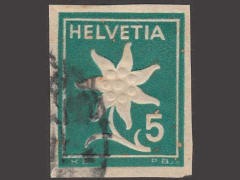

Company

